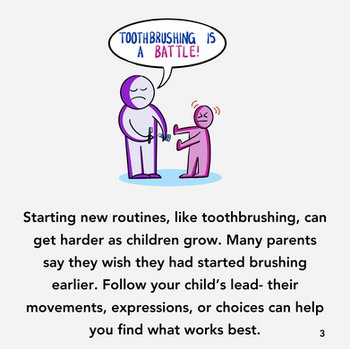
Using timers and alarms to build toothbrushing routines
Overview
Timers can be helpful for showing your child how long they need to brush for. Knowing when brushing will end (with a clear stop or exit) can make it easier to cope with, especially if they find it uncomfortable. A timer that counts down works well because it gives a clear ending point. Alarms can also help make brushing part of a regular routine and act as a reminder.
There are lots of timer options to try, such as sand timers, the portable 'Time Tracker' (the magnetic one starts at one minute), liquid sensory timers, or waterfall timers. Most of these can be flipped to make the time longer if needed. Some children enjoy watching the countdown on a smartphone timer, especially when you want to set a specific number of seconds. This can be useful if you're introducing brushing slowly. For example, some parents start with just five seconds and build up the time gradually.
Top Tip
Be cautious with timers that end with a loud alarm, as these can be startling for some children. Instead, look for timers with a gentle or visual signal to indicate time is up.

How to add timers to your child's toothbrushing routine
Some children like using timers or alarms, while others may find them too sudden or upsetting. If you think a timer could help your child, try introducing it during calm, low-stress activities first. This helps your child learn that the timer is a reliable way to show when something starts and ends. You can begin with short times and slowly make them longer as your child gets used to it. Once you start to use the timer within your toothbrushing routine, try to use the timer each time your child brushes their teeth. This consistency helps build a routine and sets clear expectations about how long toothbrushing should last. If your child enjoys things they can see or interact with, try using timers with visual features. For example, the 'Time Tracker' is magnetic and can be set for different lengths of time. Liquid waterfall timers are also a good option, they are calming to watch and easy to reset. If you prefer using a device, select countdown timer apps that are straightforward and not associated with games. This helps keep the focus on toothbrushing rather than playing. You could try a specialised timer like the ‘Time Timer’, which shows time passing in a clear, visual way. This can help children understand how much time is left. However, it may not be as helpful for very short times, like one minute.
Key messages

Watch again
Jump straight to what parents and early years professionals have said about different ways to build toothbrushing routines.




